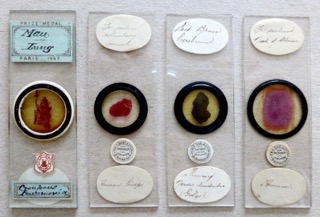Laboratorium |
||
Mikroskopische Schnittpräparate (2) |
||
Professionnelle Präparatoren klebten ein Label mit einem Firmenlogo auf ihre Präparate. Alle hier vorgestellten Gläser sind auf diese Art markiert. Arthur C. COLE "Arthur Charles Cole (1821-1900) was a Liverpool music professor. He was a member of the Liverpool Microscopical Society from 1873, and the Royal Microscopical Society from 1879. He was awarded a prize medal at the Paris Exhibition of 1867, and moved to London in 1879. His mounted slides of diatoms and histological material were of the highest quality, and most of them carried a small label with a crest and the words "Cole Deum.". "Arthur C. Cole (1821-1900) was an organist and professor of music in Liverpool. He won a prize medal at the Paris Exhibition of 1867, was a member of the Liverpool Microscopical Society from 1873, joined QMC in 1876 and RMS in 1879 before moving to London's Notting Hill. His slides of diatoms and histological subjects are of the highest quality, many of which still survive. Cole's mounts carry two beautiful labels, one light green/blue and the other a small crest with a deer that reads Cole Deum (Worship God). He mounted slides for research purposes, selling them directly to scientists and to the trade". "The most prolific microscope slides preparers (such as the professional organist and music professor Arthur Cole of Liverpool, who signed his slides with the trade name "Cole Deum") had in stock some 8,000 to 10,000 different subjects to choose from!"
Herbert William Hutton (H.W.H.) DARLASTON (1867-1949) in Birmingham operated as a commercial mounter from about 1900 until the late 1930s.
Andere große britische Präparatoren waren: - A.T. DAVIES in Keysham Arthur J. DOHERTY S.C. HINCKS in der Runfold-Lodge in Farnham E. LEONARD (1875 to 1931) in Cheshire und Birkenhead - J.A. MARTIN in Guildford - NEWTON & Co in der Fleet street Temple Bar in London - RUSSEL - P.K. SARTORY - W. WATSON & Sons in High Holborne / London. William Watson began his optical business in London in 1837 and began manufacturing microscopes in the 1870s. The firm acquired Wheeler’s stock and business in 1884 and remained major suppliers of microscopical mounts until the late 1930s. - E. WHEELER in London. Edmund Wheeler (d. 1885) gained a high reputation for the mounts he sold including Webb’s diamond engravings.
Exponate Der Objektträger als Beispiel einer frühen Standardisierung: am 20. Dezember 1839 empfahl die frisch gegründete "Microscopal Society of London", der Vorläufer der "Royal Microscopical Society", 1839 also empfahl diese Gesellschaft, daß künftig britische Objektträger die Maße 3x1 inch haben sollten – also 76x26 mm. Doch koexistierten bis nach 1900 – selbst innerhalb Englands - die unterschiedlichsten Formate. Ausgestellt sind 1 Lungen-Präparat von A. COLE sowie 3 Präparate von H.W. DARLASTON (Bizepsmuskel, Gehirn und Gebärmuttermund). Das 3. Präparat ist nach GOLGI gefärbt. Camillo GOLGI (1843-1926) war ein italienischer Mediziner und Physiologe, der 1906 den Nobelpreis für Medizin erhielt. 1873 hatte er die nach ihm benannte Färbung mit Silber angegeben, eine Methode zum Anfärben einzelner Nerven und Zellstrukturen, die als „Schwarze Reaktion“ bekannt wurde. Sie basiert auf der Entwicklung von Fotografien und war deren erste Anwendung in Geweben. Nach 30 Jahren großer Erfolge wurde die Färbung zwischen den beiden Weltkriegen zu Gunsten anderer Färbeverfahren aufgegeben. |




